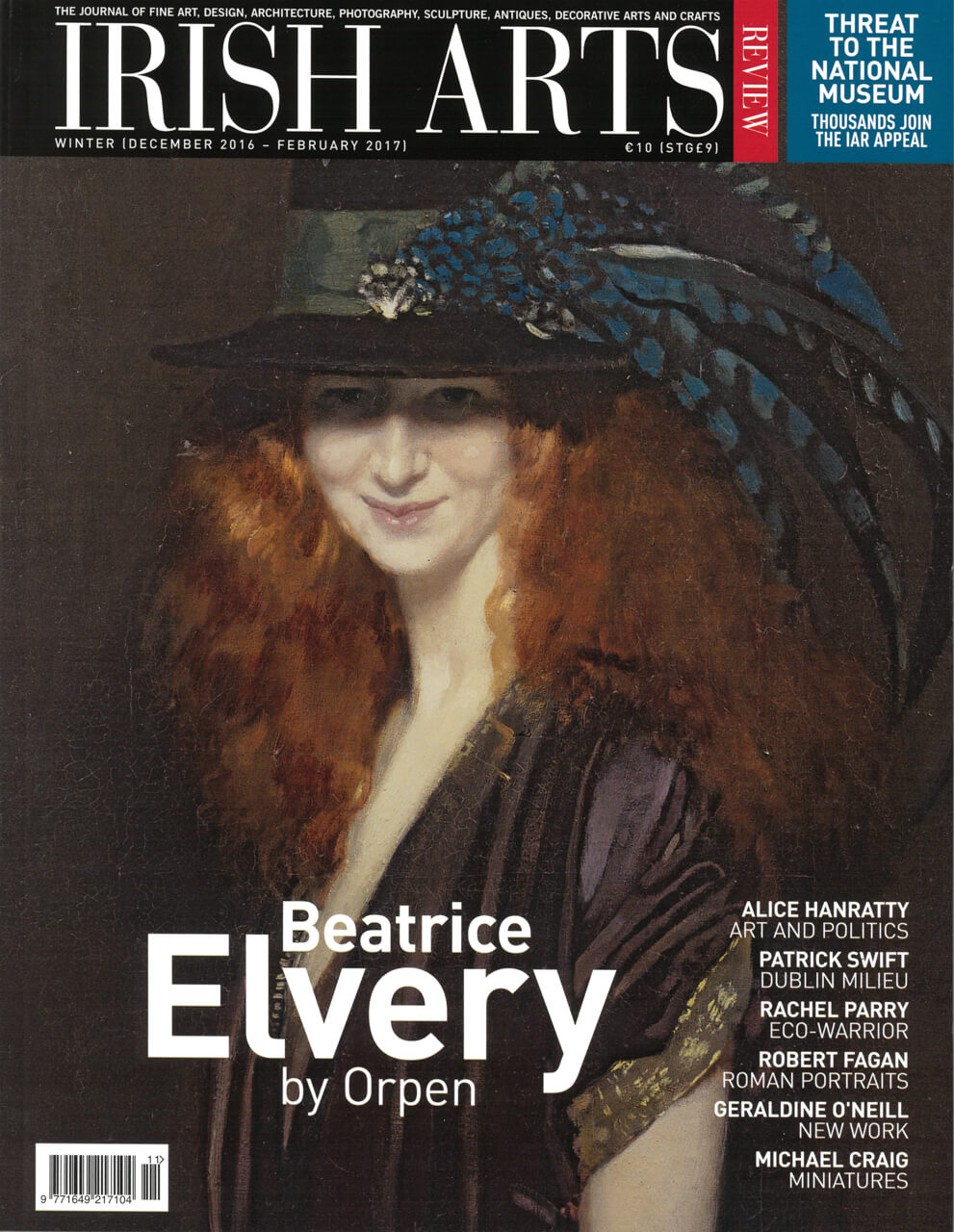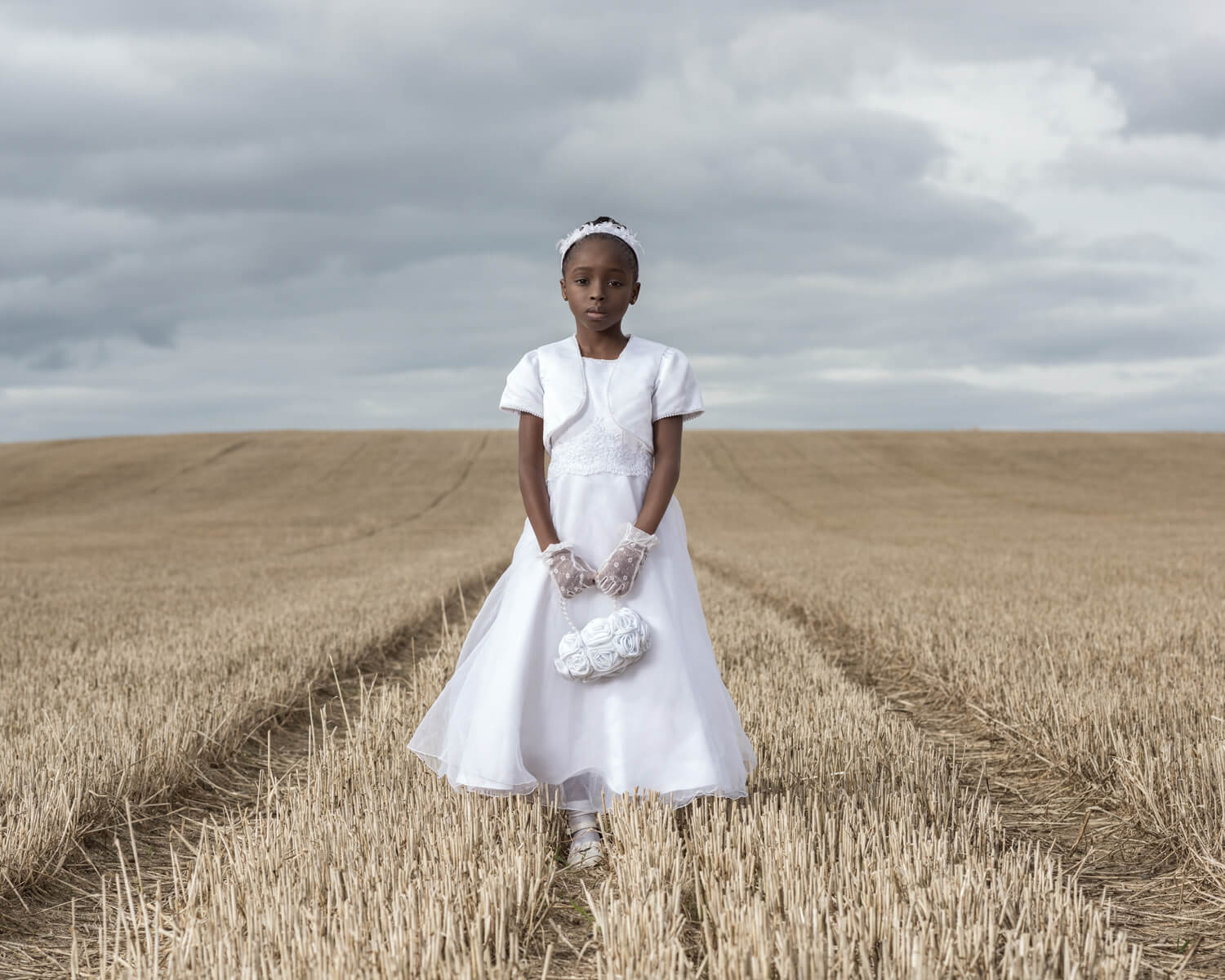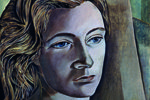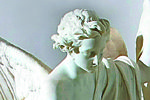
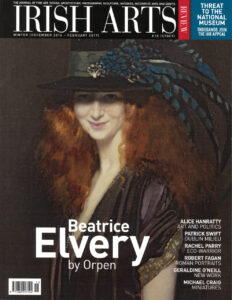
Kevin V Mulligan salutes the restoration of two exceptional architectural monuments in County Monaghan that embody a moral message about the transience of life.
In terms of conception and achievement, historic demesnes as designed landscapes constitute the most inventive, monumental, and certainly the most complex of all artistic creations. The break up of estates through the concerted campaigns of the Land Commission, the commercially driven monocultural policies of the state forestry and latterly the incompatible demands of industrialized agriculture and stealthy spread of sterile golfing resorts means that these fragile and beautiful landscapes have come to represent the rarest and most endangered art forms. The 20th-century decline of the Dartrey demesne on the Monaghan – Cavan border might stand as one of the most egregious examples of the impacts of dispassionate and poorly conceived polices that conspired, wittingly or otherwise, to erase these creations, either in a heartbeat or with a slow and painful demise. It seems unlikely therefore that the same landscape should in recent years have become the focus of two major building restoration projects by a voluntary local community group working with state bodies, which has not only achieved the physical redemption of two exceptional works of classical architecture, but has also brought about greater awareness of the historical and cultural significance of Dartrey as a designed landscape of exceptional quality, and one worth preserving in spite of its degradation.
Nature did most of the groundwork here for the creation of what was once one of the most exalted Irish demesnes. In this varied drumlin landscape, with its gentle profusion of small hills steeped among serpentine waters of the Dromore River system, ‘how infinitely short of these natural beauties will artificial improvements appear, though arranged with the purest taste’ wrote Sir Charles Coote in 1801. Originally named Dawson’s Grove, the demesne at Dartrey lay at the heart of an estate in Monaghan assembled by the Dawsons in the opportunism presented by the post-Cromwellian settlement. In the 1740s it was inherited by Richard Dawson, an Dublin alderman and banker whose merits Primate Stone assessed simply as ‘a natural dryness of temper, and an habitual attention to his private interest’.1 The failure of the Wilcox and Dawson bank in 1766 perhaps took its toll on Dawson personally who died the same year but it did not entirely disadvantage his eldest son Thomas, MP for Monaghan from 1749, who was in a position to build a new house soon after his father’s death and carry out major improvements to the demesne.
Like many of his contemporaries Thomas Dawson (1725-1813) was a connoisseur and an enthusiastic patron who had taken the Grand Tour, present in Rome in 1751 where he fell in with Lord Charlemont and his circle to be caricatured among them in Reynold’s Parody on the School of Athens. Like his fellow travellers he sat to Batoni and commissioned views from Vernet.2 On his return, in common with Charlemont, he commissioned works from all the leading artists – Reynolds for portraits, Jervais for stained glass, Wilton for sculpture and besides promoting the careers of the major Irish landscape painters Thomas Roberts and William Ashford in having them record his arcadian achievements at Dawson’s Grove, he also continued to collect old masters with works attributed to Van Dyck, Salvador Rosa, Caravaggio, Poussin and Teniers all represented in his collection.3 However, whereas Charlemont selected the well-established figure of Sir William Chambers as his architect, Dawson, having employed an unknown architect for his new house in the 1760s, later opted for the younger but promising James Wyatt (1746-1813) to design a Neo-Classical temple (Fig 6) to commemorate his first wife, Lady Anne Fermor, daughter of the Earl of Pomfret, whom he had married in 1754 and died 15 years later.4
Despite a successful political career and elevation to the peerage, culminating in a viscountcy in 1785, Dawson’s life was marked by great personal tragedy and sadness.5 Besides the premature death of his wife, all the children from his two marriages predeceased him, as did two of his heirs – his younger brother Richard, who was murdered by highwaymen at Ardee in 1782, and his attractive and immensely popular nephew, ‘Dashing Dick’ Dawson (Fig 7), on whom all of the future fortunes of the family rested until his untimely death in 1807.
Dawson’s first wife, and his nephew, were separately memorialized with buildings in the demesne, grandly conceived monuments that reflect how the commemoration of death had become a central theme in the grandest garden landscapes. Arcadian memorials, with their message of et in arcadia ego had long been an important element in the idealized landscapes of Claude and Poussin, and the symbolic and moral sentiments they embodied were influential to the increasingly intellectualised concepts applied to the 18th-century landscape traditions and within Neo-Classical ideals, with evolving attitudes towards death partly fed by improved perceptions of the ancient world and the commemorative role of architecture within it.6
In conceiving the monument that would commemorate his late wife, the newly created (and newly remarried) Lord Dartrey chose for its location the Black Island rising prominently in the lake before the house, ‘an object of infinite curiosity, use and amusement’ of about 100 acres, skirted by woods on all sides, rising to a ‘bald pate in the middle consisting of a ploughed field’. He selected a site on the side of this elevated plateau, facing the house and began what one contemporary described as ‘that awful temple, which grateful love is erecting to all the female virtues’, but which in reality took its place in a more sophisticated scenographic arrangement of the landscape, serving aristocratic ideas about the celebration of death, or as one visitor put it, to offer ‘a melancholy satisfaction in contemplating the virtue of that admirable character to whose memory it is sacred.’
Although there is no firm documentary evidence, the surviving drawings can with confidence be attributed to Wyatt, making this his earliest Irish commission (Fig 1). Wyatt, who belonged to a Staffordshire family for whom building was in the blood, had recently returned after six years in Italy, announcing his arrival in London with a design for an assembly room in Oxford Street, hailed by Horace Walpole as ‘the most beautiful edifice in England’ which in name and design was inspired by the Pantheon. When it was opened in 1772 to establish the architect’s reputation, he must already have been approached by Lord Dartrey about his temple.7 Wyatt’s designs show a building clearly intended to evoke the Pantheon, using it in his exploration of a building type that was attractive to neo-classical designers because it offered an opportunity to attempt a kind of classical purity in architecture, without being bound by any overriding or practical necessities, and it was one that Wyatt was go on to refine and perfect.8
Here on the remote and watery fastness of the island, the circular form of the Pantheon was exchanged, most likely on economic and practical grounds, for a cubic form with an apsidal projection to the rear, built in local red brick with limestone trimmings including a refined dentil cornice and pedimented frontispiece with stylized pilasters. Reference to its Roman counterpart was retained in a proud lead dome, set on a stepped base and given an open oculus in the centre, providing the only light which as the Rev Daniel Beaufort observed on a moonlit night, illuminated the interior to brilliant effect, serving to heighten the emotional drama of Joseph Wilton’s virtuoso sculptural group which filled the internal apse, giving a spectral quality to the scene with its life-size figures of Lord Dartrey and his young son, awed by the gesturing angel who has appeared before them.9
The Temple was completed by August 1774 when it was reported that Wilton’s sculpture (for which he was paid 1000 guineas) had just landed in Dublin though it is not known if the structure was ever really intended to be used as a mausoleum to receive Lady Anne’s remains.10 By 1773 Lord Dartrey only came to Monaghan ‘in full family’ for just two months in a year and with the deaths of his brother and all his remaining children in the next decade he seems to have more or less given up Ireland, purchasing a villa in Chelsea and making his departure complete in 1802 when he had the bodies of his wife and two children exhumed and brought to England.11 Having risen in the peerage as Viscount Cremorne in 1785, his nephew Richard was now heir to the estate and title. Elected to Parliament to his uncle’s seat, he was an able politician, displaying a strong independent spirit that proved deeply popular. Known as ‘Dashing Dick’ he was considered the ‘prince of country gentlemen’, though not always without embarrassment to his family and as an ardent opponent of the Act of Union, he placed his uncle, whose own career was distinguished by his loyalty to Government, in a difficult position, and quite literally too as he is said to have fainted in the company of the King and Queen when his heir’s name was sighted amongst the list of no-voters. One might even wonder if this was not the actual cause of Lord Cremorne’s decision to retreat from Ireland, but it seems that Dick’s behaviour was forgiven because after his untimely death his uncle facilitated the erection of a striking public monument to him, by ensuring it was located within the demesne (Fig 9).12
Beside the popularity of his liberal and enlightened politics, Dashing Dick seems to have been personally admired among all ‘ranks and classes of society’, remembered especially for ‘his kind disposition, his happy temper, his conciliating manners, his uniform and steady friendships’ and so to find a way to perpetuate that memory and to provide ‘a strong incitement to others to emulate such a bright example’ a local committee was appointed in November 1807, chaired by Alexander Ker of Newbliss. It decided that a ‘column of stone should be erected in some conspicuous part of the town of Monaghan with a suitable inscription’ funded by voluntary subscriptions.13 Instead, it was erected within the demesne he should, in time, have inherited. If this change was effected through the influence of his uncle (and not in deference to him), then like the temple, this monument (even though its cost was still provided by the ‘free and independent electors of the county of Monaghan’) was intended to stand not only to commemorate a figure of worth and inspiration, but also as a landscape ornament that embodied a moral message about the transience of life.
Given his earlier role in designing the temple (and later as architect at Cremorne House), it seems entirely possible that Wyatt would have been asked to design the monument.14 If he was the architect, as seems likely, it was undertaken at a time when his reputation was waning, party due to his own incompetence at the Office of Works, where his mismanagement was the subject of investigations at precisely this time, and which continued until his death in 1813.15 But art and business can be ill-suited companions and Wyatt’s ability as a designer (who, it had been said, could draw perfect circles and straight lines freehand) endured, with the Dawson Monument as perfect a design as anything else in his classical oeuvre. Completed in 1811, its stands dramatically on a hilltop on the edge of the demesne, a 60ft-high classical column in finely worked sandstone.16 Architecturally, it is less conventional than it first appears, part Roman, part Greek where only the neck of the shaft is fluted, abandoned – perhaps as an economy – in favour of a smooth column and moulded base, effecting a rare degree of sophistication that only an accomplished classicist could achieve. At the top is a swagged Neo-Classical funerary urn, its flaming top appropriately symbolic of life and death, while below, on two sides of the plinth, a medallion bears the Dawson crest and motto draped with a bay leaf garland – the words of the motto, ‘Toujours Propice’ cruelly mocked by the series of personal tragedies that culminated in this monument.
Dashing Dick’s son Richard eventually inherited Dawson’s Grove in 1813, succeeding to the barony of Cremorne created specially in 1797. After his death the neighbouring demesne of Fairfield was purchased, extending the Dawson demesne to over 1,000 acres and in 1843 William Burn, sparing interiors of the Georgian house, transformed it into Dartrey Castle, an enormous Elizabethan-Revival fantasy cast with gables, mullioned bay windows, domed towers and tall chimneys.17 The family added to their own glory too, created earls of Dartrey in 1866 but with the death of the 3rd Earl in 1933, the family and their demesne seem to have been reaching their natural conclusion together. Lady Edith Wyndham, the elder daughter of the 2nd Earl inherited the property, but was the last to live there, forced out by penal rates and the economics of maintaining such a vast house. The contents were dispersed in 1937 and in 1946 the Hammond Lane Foundry paid £3,000 for the salvaged materials of a house that exactly a century before had cost ten times that to build. Today only its vaulted basements, presenting half-buried arches rather like the remains of a Roman bath, gape magnificently, if reproachfully, out over the grass-grown terraces and the lake.
After the demolition of the house and sale of lands, the island was given over to commercial forestry, where the temple had conifers planted right up to its walls.18 Quickly swallowed up, by 1960 the roof had fallen in and the weather and vandalism had begun to take its toll, especially on Wilton’s monument despite early efforts at restoration by The Irish Georgian Society. The Dawson monument was similarly lost, its urn disappearing among the treetops while all around it the lodges fell vacant and were abandoned and the walls tumbled down. Even the two imposing stable blocks, despite being in good condition, were abandoned, and ever since have been quickening to ruin.
Only the most determined and appreciative minds could have believed that all was not lost, not entirely. It seemed most unlikely then that any opportunity to arrest the decline would have been possible. Yet through the interest, enthusiasm and commitment of the local community, led principally by Noel Carney, Andrew McCaul and Bertie Mills, Dartrey Heritage Association was formed in 2003, and began working with Coillte Teoranta to initiate the restoration of the Dawson Monument, which with funding under the Peace and Reconciliation Programme was largely achieved by 2005, when attention turned to the temple. Its isolated location meant that vandals and thieves had successfully transformed Wilton’s monument from being the high point of Neo-Classical art to a dismembered and shattered ruin. By 2005, after further negotiations with Coillte and the support of its regional manager George Beirne, a license was granted and restoration works began under the direction of John Redmill, with specialist advice on the sculpture from Jason Ellis. With funding from a variety of public and private sources the reconstruction of the dome was achieved, as well as repairs to the interior and eventually, works to the sculpture, which first of all required many of the missing pieces to be located – including the head of the angel which had found its way from a Garda station into a private collection – and their repatriation negotiated. Although some elements, including the head of Lord Dartrey have not yet been recovered, it was possible to model the head in herculite based on images and a contemporary bust of Dawson by Wilton that is now in the Yale Centre for British Art, the triumphant results carried out in Cork by Nicola de Silvestri of Carrerra in association with the Irish conservator Eoghan Daltun (Figs 3&4). In conjunction with Coillte’s enhanced environmental policies, the present plans are centred on re-opening the historic vistas and the replacement of the spruce woods with suitable planting.
Even in extremis, in what might have seem a ravaged, forgotten landscape, the underlying qualities of the natural topography and the man-made embellishment of this extraordinary landscape have endured awaiting rediscovery; the hills fold in the same ways between the lakes, and old planting still dominates in places where venerable oaks can be found rising majestically above evergreen upstarts, and there are even thrilling vistas to be glimpsed unexpectedly, especially those across the water to Bellamont Forest, part of visual inter-relationship between these neighbouring demesnes that was considered in 1772, a communication of beauty, ‘very striking and uncommon’. St John’s Church, the towered brick church erected in the demesne in 1729 by Richard Dawson for ‘the convenience and accommodation of his family’ is still in use, and continues to command views from it wooded slope on the edge of the demesne.19 Even if the 18th-century villa and the extraordinary Elizabethan-Revival extravaganza that replaced it are gone forever, many good buildings survive, and thanks to the heroic efforts of sensitive and inspired local community the groves of arcady are now slowly being redeemed for posterity.
Kevin V Mulligan is an architectural historian.
1 As a partner in the bank of Wilcox and Dawson founded the same year as his Monaghan inheritance there was clearly enrichment; but like most banks in the eighteenth century it was shortlived and Dawson suffered a series of crises before closing down in 1766 with debts estimated at £192,000. The failure of banks is understandable perhaps with spendthrifts like Lord Charlement as customers, but ultimately there was a run on the Dawson bank in 1755 when in an unregulated environment it was discovered that a member of staff had appropriated £60,000, building and furnishing a house for himself before being found out. In one of those truth-affirming resonances of history, of lessons unlearnt, the consequences were summed up by the Lord Chancellor: ‘the creditors are distressed and the public must suffer‚Ķ’
2 He also seems to have first commissioned the Neapolitan aritist Gaspare Ricciardelli, while in Italy. Among the works of art sold from Dawson’s London house in 1827 after the death of his widow, were ‘a sea port by Moonlight’ by Vernet as well as four views of Naples and the Bay by Ricciardelli.
3 As evidence of his influential patronage, Dawson’s commission to a young Thomas Lawrence in 1788 for twin portraits of himself and his second wife seems to have won the artist the royal commission that launched his career, Lady Cremorne then being a lady-in-waiting to Queen Charlotte. When Dartrey was finally emptied of its contents in the 1930s there were also pictures attributed to Ramsay, Hogarth, Zoffany, Coates and Hugh Douglas Hamilton.
4 Dawson’s house, probably commenced soon after he succeeded in 1766, was noted two years later as ‘a choice house’. A detailed survey of the building, made by William Burn in 1843, shows a rather sophisticated red-brick villa, partly inspired perhaps by Bellamont but more distinctly neo-classical with a narrow canted bow on the garden front. Although the architect for the house is not known, one candidate is Stiff Leadbetter, a competent London architect who designed a number of compact Palladian villas and was employed by Lady Anne Dawson’s mother, the Countess of Pomfret and her brother in law, Thomas Penn. Leadbetter died in 1766. Howard Colvin, A Biographical Dictionary of British Architects 1600-1840, 1995, 603-4. G. Jackson-Stops, ‘Cliveden Album II’ in Architectural History, 20, 1977, 71.
5 Created Baron Dartrey in 1770, Dawson was ennobled further in 1785 when he was created Viscount Cremorne. Following the deaths of his children he was granted the title Baron Cremorne in 1797 with a special remainder in favour of his nephew, Richard Dawson and his successors.
6 Dawson’s interest in exploring the theme of death in arcadia is revealed in the painting he commissioned from Ricciardelli, showing rather fancifully, the construction of the Dawson Temple which was in fact painted after the event. For discussion see William Laffan and Brendan Rooney, Thomas Roberts 1748-1777, 2009, 91-109.
7 Wyatt went to have a long and successful career, culminating in 1796 when he succeeded Chambers as Surveyor-General and Comptroller of Public Works. He enjoyed an extensive practice in Ireland, where besides the Dartrey Temple his earliest commissions included Lucan House and Abbeyleix, whose patrons, significantly, shared kinship with Lord Dartrey.
8 Principally in the more ambitious (and expensive) Darnley and Pelham Mausoleums in England of the 1780s (in Kent and Lincolnshire) and again in Ireland with the Malone Mausoleum at Kilbixy, Westmeath in the 1790s. John Martin Robinson, James Wyatt, 2012, 167-183.
9 Joseph Wilton (1722-1803) who had trained in France and Italy, had been appointed sculptor to George III in 1764, which may have influenced Dawson in his choice of sculptor, as his second wife Philadelphia Hannah Freame whom he married on 1770 (and niece of Thomas Penn, Lady Anne Dawson’s brother-in-law) was a lady-in-waiting to Queen Charlotte. The epitaph inscribed on a panel at the base of the monument was penned by Lady Anne Dawson’s friend, the poet Elizabeth Carter, and is evidence of the Dawsons’ association with the literary world of Burke, Garrick, Goldsmith, Reynolds and Dr. Johnson.
10 It seems more likely that Lady Anne was interred with her daughter in the family crypt at St. John’s, the demesne church, located near the house.
11 The Dawsons- 11 year-old daughter Henrietta died in 1767, and their 19 year-old son Richard died in England in 1778 and his remains brought to Dawson’s Grove. Hampshire Chronicle 2 March 1778.
12 Once the Act was passed, Dawson seems to have agreed ‘to induce his constituents to reconcile themselves to its provisions’. E.M. Johnston-Liik, History of the Irish Parliament 1692-1800, IV, 2002, 28-29.
13 Belfast Commercial Chronicle 28, Nov. 1807; 12 Dec. 1807
14 Chelsea Farm, built by the Earl of Huntington in 1740s and later lived in by Richard, Viscount Powerscourt until 1761, was purchased from the Duke of Bridgewater. Dawson employed the architect to ‘enlarge and embellish’ the building which he renamed Cremorne House following his elevation to the Viscountcy. It appears that for the landscape around the house he employed Nathaniel Richmond, an assistant to Capability Brown, who later with Joseph Farington became a member of John Penn’s (who was Lady Anne Dawson’s nephew) Committee of Taste at Stoke Park. So far Richmond’s is the only name that can be put forward as a possible candidate in connection with designs for the landscape at Dawson’s Grove.
15 Howard Colvin, A Biographical Dictionary of British Architects, 1995, 1108. The attribution of the Dawson Monument to Wyatt, relies not only on circumstantial evidence, but on stylistic grounds, resembling as it does the column erected by John Penn in the 1790s to the commemorate Sir Edward Coke at Stoke Poges, Buckinghamshire, which was itself similar to the earlier monument by Wyatt erected at Wynnstay to Sir William Watkins Wynn.
16 Originally located inside the demesne, its relationship with the landscape was altered following the realignment of the public road in the 1950s.
17 When within a decade the new house was seriously damaged by fire, its total destruction was prevented because of the existence of the dividing wall between the old and new structures, which limited the damage to the east end, including the family’s private apartments and the drawing room.
18 The temple dome had been replaced in the 19th century by a big hipped slate roof and its external brick walls were coated in plaster. See illustration in Maurice Craig and The Knight of Glin, Ireland Observed, 1970, 38.
19 The building is now of several different periods, the transepts and apse added at different times and the tower rebuilt in 1840.
